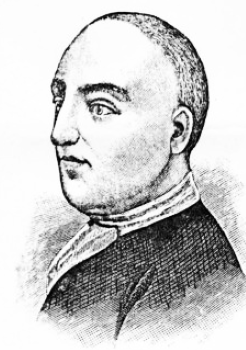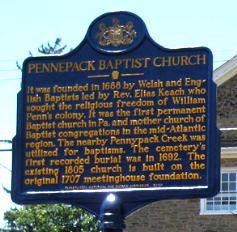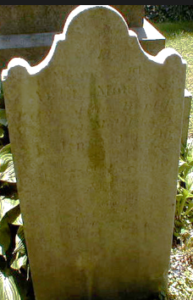Title: Baptist preacher, pastor
Birthdate: 1673
Death Date: December 16, 1722
Plot Location: Section 112, First Baptist Church plot

The country of Wales is about the size of New Jersey, situated on the island of Great Britain to the west of England. It has remained a culturally distinct member of the United Kingdom primarily because of the Welsh language.
This is where Abel was born, at a time when English was secondary to Welsh. His family was an educated one; his grandfather wrote several books, his uncle became a famous poet, and his father became an ordained minister in the Baptist Church in his later years..
It was also a time of discrimination against Baptists and other Protestant “non-conformists” by the Church of England. His mother became a widow in 1680 and married Rev. John Griffith. Influenced by both his father and step-father, Abel preached his first sermon at age 19, and was called to pastor a church a few years later. His brother Enoch and half-brother Benjamin Griffith also became preachers. Seeking freedom to worship, Abel’s siblings were part of a significant Welsh migration to America at the turn of the 18th century.
Priscilla Powell became Abel’s wife in 1702 and gave birth to two children. Abel wrestled with the “push/pull” considerations in whether to join the migration. He received pushback in the form of government regulations and restrictions on the Baptists, especially as Abel’s church grew to several hundred  members. The pull came in the form of a call to pastor the Pennepack Baptist Church north of Philadelphia (in today’s Bustleton section where the church is still active today). His siblings and step-father had already settled there, then went on to begin a church with others from Wales near what is now Newark, Delaware.
members. The pull came in the form of a call to pastor the Pennepack Baptist Church north of Philadelphia (in today’s Bustleton section where the church is still active today). His siblings and step-father had already settled there, then went on to begin a church with others from Wales near what is now Newark, Delaware.
Abel felt led by God to make the move and didn’t waiver when the journey turned tragic. The family packed and left in September of 1711 but was held up in Ireland for several weeks due to bad weather. Then sickness and winter’s cold led to the death of Abel’s wife and son during the voyage. It wasn’t until February that he and daughter Jane finally stepped on land to the welcome of relatives and the growing Welsh community in Pennsylvania.
Whether or not he already knew English, it was a new country and culture. Abel also had to navigate the challenges of being a single father. He married again in 1714 but his second wife died less than a year later. His third wife, Judith, gave him four more children, naming two of the boys Enoch and Abel. Those were the names his brother Enoch gave to two of his boys, making the family tree a bit complicated. Abel had siblings, cousins, and nephews who became preachers, part of a Morgan dynasty that spread the Gospel as they traveled among Welsh communities in other  states like Virginia and North Carolina. A large clan of Morgans can be found today in South Carolina.
states like Virginia and North Carolina. A large clan of Morgans can be found today in South Carolina.
In addition to his regular duties, Abel organized “daughter” churches in Chester and Montgomery counties and in New Jersey. For a time he filled the pulpit at both Pennepack and the first Baptist church that was founded in the heart of Philadelphia. All of them became part of the Philadelphia Baptist Association that offered counsel, encouragement, and mutual aid.
As a result, the number of churches continued to multiply, including more than 100 by the end of the century, reaching from the Welsh Neck of South Carolina to New York. Abel translated the Baptist Confession of Faith into Welsh and promoted Bible training to equip future church leaders.
The Philadelphia Association would later sponsor the Academy of Rhode Island which became known as Brown University. His most notable achievement, however, was in compiling the first concordance of the Welsh Bible, an alphabetical index of all the words used in scripture. His was the basis of one published in 1773 which is still used today in Wales.
Abel died at age 49 but his ministry carried on in many ways through his relatives and descendants. His brother and step-brother were among 26 men who filled the pulpit at First Baptist Church of Philadelphia from 1698-1746. Two nephews were Baptist preachers in the South.
Sources differ on whether Abel died while preaching in Randolph County, North Carolina or while in Pennsylvania. Either way, he was originally buried at the Pennepack Baptist Church Cemetery. His gravestone, shown here, is still there today, although his grave isn’t.
Judith had his remains moved to the burial ground at First Baptist Church in Philadelphia after she  became a member there in 1768. Buried with them were their daughter Rachel and son Abel Jr. along with Abel III and two of his children.
became a member there in 1768. Buried with them were their daughter Rachel and son Abel Jr. along with Abel III and two of his children.
The family’s remains were moved in 1860 to Mount Moriah but Abel’s gravestone wasn’t. The church kept it to remember one of their forefathers. When a new sanctuary was built at 17th and Sansom Streets that stone was mounted on a stairway wall. It’s there today in tribute to one of the pioneers of the Baptist Church in the middle colonies of America.

Support the Friends of Mount Moriah
Help us in our mission to restore and maintain the beautiful Mount Moriah Cemetery by donating to our cause or volunteering at one of our clean-up events.

